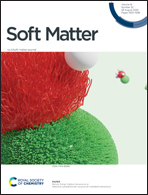Topological defects due to twist-bend nematic drops mimicking colloidal particles in a nematic medium†
Abstract
Colloids formed of solid/fluid particle dispersions in oriented nematic liquid crystals are known to be an ideal means of realizing fundamentally significant topological defect geometries. We find, experimentally, that twist-bend nematic (NTB) droplets formed in the N–NTB biphasic regime, either of pure compounds or mesogenic mixtures, completely mimic colloidal particles in their ability to generate a rich variety of defects. In the biphasic regime, the topological features of both liquid crystal colloids and chiral nematic droplets are revealed by (i) topological dipoles, quadrupoles and their patterned clusters formed in planar nematic liquid crystals orientationally perturbed by coexisting NTB drops, (ii) the transformation of hyperbolic hedgehogs into knotted Saturn rings encircling the NTB drops dispersed in a 90°-twisted nematic matrix and (iii) the Frank-Pryce defect texture evident in smaller (relative to sample thickness) NTB drops. In larger drops with fingerlike outgrowths, additional line defects appear; most of these are deemed to be pairs of disclinations to which are attached pairs of screw dislocations intervening in the growth process of the NTB droplets.



 Please wait while we load your content...
Please wait while we load your content...